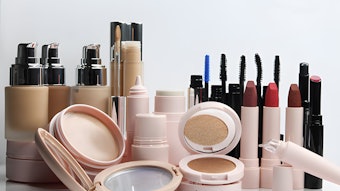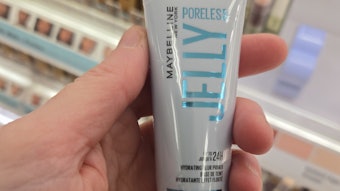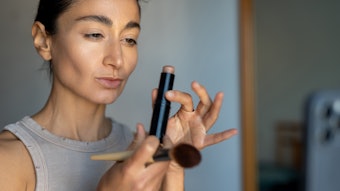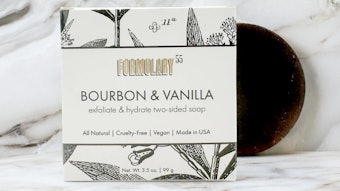
The global color cosmetics global market is expected to reach US $77.7 billion by 2020, according to Markets and Markets.1 This growth will be fueled by demand from exacting consumers seeking a plethora colors, finishes, textures, etc. Cosmetics also are no longer just fashion accessories, they must provide lasting, non-irritating skin benefits in convenient forms. They should create the impression of a healthy, natural skin glow; or deliver bold and dynamic colors to the lips, eyes and nails—all while applying easily and uniformly, with good texture, skin feel and durability. Some of the latest color product forms and claims include the following.
Multifunctional products: Long-lasting, perfect wear, two-in-one, wet and dry, color release, adjustable color, oil-free/oil control, low luster/matte finish, dewy finish and light-diffusing;
Color with health benefits: Sun protection, moisturizing, fragrance-free, hypoallergenic and non-comedogenic;
Color plus convenience: Water-resistant/proof, smudge-proof, powder to liquid, slimline, refill pack, trial size;
Color plus visual effects: Mottled, swirled, two/three-in-one, confetti, three-dimensional effects and liquid crystals; and
Back to nature: Eco-friendly, natural/herbal ingredients, non-synthetic, environmentally friendly and not tested on animals.
Multicultural Market
In recent years, the demand for multicultural beauty products has grown in part due to the expanding middle classes in emerging markets. In fact, the multicultural segment has the potential for becoming the largest market for cosmetics companies. Market research group Kline reported that in 2014, the multicultural beauty products market grew 3.7% in the United States alone, outpacing the overall market for cosmetics and toiletries. And considering that three-quarters of the world’s population is now non-Caucasian, the days of limited shade ranges and “niche” hair product lines could quickly become history.2
According to Oru Mohiuddin, strategy analyst for Euromonitor International, “Caucasian consumers have thus far received more attention for their higher purchasing power, given that per capita spending on beauty in North America and Western Europe is nearly seven times more than that of Asia-Pacific … But the Western markets representing Caucasian consumers are saturated, whereas non-Caucasian consumers, in the Western as well as other regional markets, represent untapped potential for future growth. This is further coupled with the fact that the purchasing power of non-Caucasian consumers globally is also rising.”3
Susan Akkad, senior vice president of local and cultural platforms and corporate innovation for The Estée Lauder Companies Inc., concurred, in Beauty of Fashion, “There’s this incredible increase in the middle class, very often driven by women’s higher education in a lot of these markets, that is fueling and increasing the consumption class.”4
In response, some cosmetic manufacturers have acquired ethnic beauty businesses with existing consumer bases to build multicultural beauty divisions. Others export their existing brands to emerging markets, in multiple shades and with multilingual, in-store beauty advisors and ethnically diverse models in product advertising. Regardless of the business approach, the key is to get formulas right by addressing skin tone as well as the unique needs of ethnic skin. To address skin tone, first consider the basics of color perception.
Basic Color Science
As a review, color is a sensation evoked by the physical stimulation of light-sensitive elements in the human retina known as cones. This stimulation is caused by electromagnetic radiation in the visible light spectrum comprising wavelengths between 380 and 780 nm. Cones can be separated into three classes, each of which is sensitive to a different spectral distribution of radiation: red, blue and green. Many different spectral distributions can produce the same perceived color, a phenomenon known as metamerism, which is fundamental to the science of color measurement.
Color is the result of perception, not an objective component of a substance. It is a psychophysical response to a reaction in the eye, and the brain’s related interpretation of it. As is well-known, objects absorb certain wavelengths and reflect others back to the viewer, which we perceive as color. As such, different individuals perceive color differently.
Color Synthesis
There are two main types of color synthesis: that reflected by an opaque object and that transmitted through a medium. These are referred to as subtractive and additive color synthesis, respectively.
Subtractive color synthesis begins with white and ends with black. As opaque color is added, the eye perceives less and less of the full white spectrum, thus the color becomes darker and eventually reaches black. The most basic colors in the subtractive system are cyan (C), magenta (M), yellow (Y) and black (K) (see Figure 1). This is what we see in nature, and the number of possible CMYK color combinations is limited. Painters, printers, color formulators, etc., use a white base to mix these opaque colors to achieve the desired shade.
On the other hand, the additive color system, which is used in television and computer displays, starts with black (the absence of light) and transmits single wavelength colors that, once all are added together, eventually create white light. In the additive system, the primary colors are red, green and blue (RGB) (see Figure 1). These can create a nearly limitless number of color possibilities, although additive colors are metameric and cannot be printed. This poses a challenge to display makeup color options via additive-type backlit technologies, such as smart phones and tablets, that match the color shade of subtractive-produced cosmetics.
In either case, color is reflected or transmitted to the eye. And no matter how complex its wavelengths, it is reduced to three color components—red, green and blue—by the cones in the eye. For each location in the visual field, the three types of cones yield three signals based on the extent to which each is stimulated. These RGB stimulus levels are often referred to as tristimulus values.
While the mechanism of perception is the same for consumers, as stated, each resulting perception is unique to the individual. Interpretations may occur based on the medium through which the light travels, one’s mood or emotions—even lighting in the boutique where cosmetics are “tried on” for purchase. Thus, the cosmetics industry offers colors that are liked by most but in a range that appeals to all.
The human eye has a good capacity to sense color, so most formulators can visually match products to skin tones. Still, a range of shades offers consumers a choice.
Color Measurements
As described, the absorption and reflection (see Definitions for related color terms) of different wavelengths of light produces color, and these wavelengths can be measured by devices such as a spectrophotometer or colorimeter. In both cases, multiple sensors receive transmitted or reflected light via a microprocessor. Both measure either emissive or reflective light, and are available in lab versus consumer grades. The main difference is how they read color.5
According to equipment manufacturer HunterLab,6 a colorimeter is designed to perform a psychophysical sample analysis by mimicking human eye-brain perception. In other words, it sees color the way humans do. Colorimeters use a set illuminant and Commission Internationale de l’Éclairage (CIE) 10-degree standard observer combination, along with a tristimulus (RGB) absorption filter that isolates a broad band of wavelengths. From this, the colorimeter distills color information into X, Y and Z values that produce objective color data.
In contrast, a spectrophotometer takes full spectrum color measurements, rather than isolating wavelength bands. By providing the wavelength-by-wavelength spectral analysis of a sample’s reflectance, absorbance or transmittance properties, it produces precise data beyond that observable by the human eye.
Perhaps the most familiar color space descriptor to cosmetic chemists is the device-independent CIE L*a*b* or CIELAB. This three-axis model includes a dimension for lightness (L), as well as dimensions for the green/red (a) and blue-yellow (b) color opposites. This model also seeks to mimic human vision by adding the component L to account for the human perception of lightness.
Although the L*a*b* color space is often considered the most exact representation of color, it is not the most commonly used. Typically, it is converted to the simplified color spaces of RGB and CYMK.7 There are other adaptations of the L*a*b* color matching system as well, including the Munsell color wheel and the Pantone color chart. In my experience, however, I find that nothing compares with the human eye. Our eyes have a good capacity to match color, so formulators can, in most cases, visually match pigments in products to various skin tones. Still, a range of shades often is developed to give consumers a choice in what they perceive as matching best.
Colorants and Nomenclature
Over decades, the U.S. Food and Drug Administration (FDA) has taken up the monumental task of assessing the safety of color additives. The administration generally classifies them in two groups: those requiring certification, and those exempt from certification, described next.8 In addition, many regulating bodies restrict the use of colorants at certain use levels and for given body sites. Formulators should familiarize themselves with the rules of the market for which they are developing a product.
Certification required: Color additives originally derived from coal tar—today, primarily from petroleum—are known as coal-tar dyes or synthetic-organic colors. Coal-tar colors consist of one or more substances either made from coal-tar or derived from intermediates of the same identity as coal-tar intermediates. They may also include diluents or substrata.
This is the largest group of colorants. Many are azo dyes—i.e., dyes whose molecules contain two adjacent nitrogen atoms between carbon atoms—but many other organic group-based dyes such as quinoline, xanthene and indigoid are also used. Except in the case of coal-tar hair dyes, these colors must not be used in the United States unless the FDA has certified that the batch in question passes the FDA’s lab analysis for composition and purity.
Certification-exempt: Exempted color additives are obtained primarily from mineral, plant or animal sources. They are not subject to batch certification requirements but they are still considered artificial colors. And when used in cosmetics or other FDA-regulated products, they must comply with the identity, specifications, uses, restrictions and labeling requirements stated in the regulations.
Examples of these “natural” colors include:
- Annatto, extracted from annatto seeds with color varying from butter yellow to peach;
- Caramel, brown in color and derived from the careful heating of sugar, molasses, dextrose, etc.;
- Carmine or cochineal extract, a strong violet color derived from the bodies of the female insect Coccus cacti;
- Beta carotene, a bright orange/red color derived from carrots, alfalfa and
certain cereals; - Iron oxides (natural and synthetic);
- Ultramarines;
- Bronze and copper powder; and
- Manganese violet.
Additional classifications: Beyond classification by certification requirements, the FDA also refers to color additives as straight colors, lakes and mixtures. Straight colors are color additives that have not been mixed or chemically reacted with any other substance; for example, FD&C Blue No. 1 or Blue 1.
Lakes are formed by chemically reacting, e.g., via adsorption, coprecipitation or other chemical processes, straight colors with precipitants and substrata; for example, Blue 1 Lake. Since lakes are not soluble in water, they often are used to keep a color from “bleeding,” as in lipstick.
Mixtures are color additives formed by mixing one color additive with one or more other color additives or non-colored diluents without using a chemical reaction. One example is food ink used in confectionery applications.9
Naming conventions: In the United States, certified color additives generally have three-part names, including: a) a designation for approved use, such as FD&C, D&C or External D&C; b) a color; and c) a number. Regarding the approved use, F refers food, D to drug and C to cosmetic. For example, “FD&C Yellow No. 5” is approved for use in food, drug and cosmetic applications. Certified colors also may be identified in cosmetic ingredient declarations by color and number alone without a prefix, such as “Yellow 5.” Certification-exempt color additives are simply listed by name.
In Europe, color additives are referred to by their assigned European Commission (EC) number, e.g., E102 (tartrazine). However, many countries also list colors by their Color Index (CI) number. These are assigned by the Society of Dyers and Colorists in the U.K. This scheme covers colors used in food, personal care and cosmetics, as well as household products and fabric dyes; for example, CI19140 (tartrazine) or CI45430 (erythrosine).
Formulating for Multiethnic Skin Needs
Multiethnic skin requires a broad array of color formula options to ensure the best match. In addition, like any other skin type, it is important to consider fundamental skin differences. African skin, for example, contains less moisture. And pore sizes vary among ethnicities.
Mohiuddin described key considerations of formulating for ethnic differences, which in some cases can add cost. “This [approach] requires more complex formulations, necessitating the use of rare and uncommon ingredients. Foundation for [Caucasian] skin requires a maximum of three different shades, whereas ethnic skin requires a greater number of shades. In addition, texture needs to be carefully engineered, as products can appear chalkier on ethnic skin.”3
In addition to color, texture must be carefully engineered, as products can appear chalkier on ethnic skin.
Texturizing agents, sebum absorption: In general, texturizing agents provide skin smoothness, and fill in lines and wrinkles. They can also moisturize and add brightness, soft focus and optical effects. Nylon powders improve application to the skin, while silica or polymer beads also create soft focus effects. Concerning oily skin, microsphere powders with a high degree of porosity absorb sebum, thereby suppressing greasiness and improving the overall finish for a shine-free effect.
Pigments: Inorganic pigments, especially iron oxides and titanium dioxide, are generally used in all foundation shades. Such pigment dispersions typically consist of surface-treated pigments milled together with a dispersant and a liquid silicone, water, an ester, or natural oils. In some cases, the base formulation may need to be adjusted so the iron oxides are better dispersed within the overall system, to promote better color value. Greater levels or different types of emulsifiers or dispersants may be required to address this. Predispersed pigments in oils and solvents work well in solving this problem.
Stability and rheology: Note that increased levels of iron oxides in makeup emulsions can affect stability and rheology. This is due to differences in the oil absorption of the pigments and the presence of water-soluble salts. Thus, surface-treating iron oxides with coatings such as silicones, isopropyl titanium triisostearate, fatty acids, lecithin or other substances helps to improve color dispersion and stability.
Balancing color tone: As stated, formulators can use devices such as a spectrophotometer linked to a computer to balance tones and achieve the desired color. Titanium dioxide, typically from 3% to 10%, is widely used as the primary white pigment to achieve color balance and opacity. Zinc oxide, from 1% to 10%, is also used on occasion; usually no more than 3% to 4% for darker ethnic or black African shades.
Special and natural effects: For special effects, pigments such as transparent iron oxides—e.g., red iron oxide (Fe2O3), yellow iron oxide (Fe2O3 • xH2O) and black iron oxide (Fe3O4), whose refractive indices are very similar to the foundation medium, can be included to achieve desired hues. Such iron oxides are typically nanoscale in nature, and as their particle sizes become smaller, their chalky appearance on ethnic skin tones becomes less noticeable. Due to their transparency, these pigments allow complex, darker skin tones to shine through makeup, giving a more natural color appearance. Multi-color pearlescent pigments can also create shimmering, tonal effects on the skin.
Ultramarine pigments such as blue may also be used either to supplement or replace black iron oxide in specific foundation shades, especially where a more vibrant, darker tone is essential. Due to the low refractive index of ultramarine blue, it has a high degree of transparency and becomes very dark when paired with oils or esters that are close to its
refractive index.
Transparency and fillers: Microsphere pigments can improve the transparency of products on ethnic skin when dispersed in the right medium. For example, in one study, color experts from Kobo Products measured the contrast ratio of 30 raw materials, including microsphere pigments and powders dispersed in jojoba oil, using a spectrophotometer; contrast ratio refers to the transparency/opacity of an ingredient or a formulation. Five measurements were taken for each material and averaged. Here, microspheres and a number of fillers, such as barium sulfate and lithium magnesium silicate, were found to be very transparent. In addition, talc and mica (muscovite), the most commonly used fillers, had not only good transparency, but were relatively inexpensive. Biotite was another filler option; it combines the properties of mica with iron oxides.
Generally speaking, the remaining microspheres and fillers were translucent, with the exception of boron nitride, which was opaque. Boron nitride, however, can be used for improving all shades by replacing titanium dioxide or zinc oxide at varying levels. It has excellent cosmetic properties due to its hexagonal plate structure—similar to the well-known lubricant graphite.
Inorganic pigments also vary in opacity, depending upon their particle size and chemistry. Ultramarine blue and other ultramarines are translucent; as is nano-sized zinc oxide. Nano-sized titanium dioxide also demonstrates low opacity.
SPF and Customization
It is worth mentioning that for today’s demanding market, color cosmetics have been developed to impart multifunctional benefits such as SPF; or to enable customizable color and benefit options. To provide sun protection, pigmentary and nano-sized pigments of titanium dioxide and zinc oxide are used in multiethnic formulations. And customization has evolved to ensure better color-matching; Boots’ No. 7, for example, employs X-Rite’s hand-held spectrocolorimeter in-store to measure an individual’s skin tone from a multitude of angles, to be sure to match skin tones as accurately as possible. This color-sensing technology was driven by demand from consumers who indicated they would change their foundation if a better match could be found.
Similarly, Sephora and Pantone’s Color IQ Tool uses a handheld device to take pictures of consumers’ skin. A Pantone number is then assigned and an iPad app generates a list of matching foundations available in Sephora stores and online.
Furthermore, do-it-yourself (DIY) concepts are creeping onto the personal care radar, more and more. Finding Ferdinand, for example, produces custom-made lipstick shades by sending a lip palette to consumers in the mail, which they then mix to their preferred shade. Thus, the consumer can become the creator.
Foundation’s New Frontier
While formulators are charged with mixing a full spectrum of color shades, technology is making the matching process easier. These smart, outside-of-the-box concepts are taking great strides for the beauty industry. Still, natural light is ideal for seeing the true match. In the end, there is room for the industry to extend the color palette beyond medium caramels, to women of dark chocolate tones—in a natural, personalized way.
References
All websites accessed on August 1, 2017.
- marketsandmarkets.com/PressReleases/color-cosmetic.asp
- getthegloss.com/career-news/multicultural-beauty-looks-set-to-become-bigger-than-ever
- Multicultural Beauty Represent Untapped Market Potential but Not Without Challenges, euromonitor.com?utm_campaign=Allured&utm_medium=Licensing&utm_source=Partner&utm_content=Cosmetic%20Toiletries%20Science%20Applied
- businessoffashion.com/articles/intelligence/sixty-six-shades-skin-tapping-multicultural-beauty-market
- http://support.datacolor.com/index.php?/Knowledgebase/Article/View/1231/32/whats-the-difference-between-a-spectrophotometer-and-a-colorimeter-ive-been-told-that-a-spectrophotometer-is-better-but-im-unclear-on-how-and-why
- hunterlab.com/blog/color-measurement-2/colorimeter-vs-spectrophotometer-knowing-the-differences-among-color-measurement-technologies/
- mathworks.com/discovery/lab-color.html
- fda.gov/forindustry/coloradditives/coloradditivesinspecificproducts/incosmetics/ucm110032.htm
- fda.gov/forindustry/coloradditives/regulatoryprocesshistoricalperspectives/











